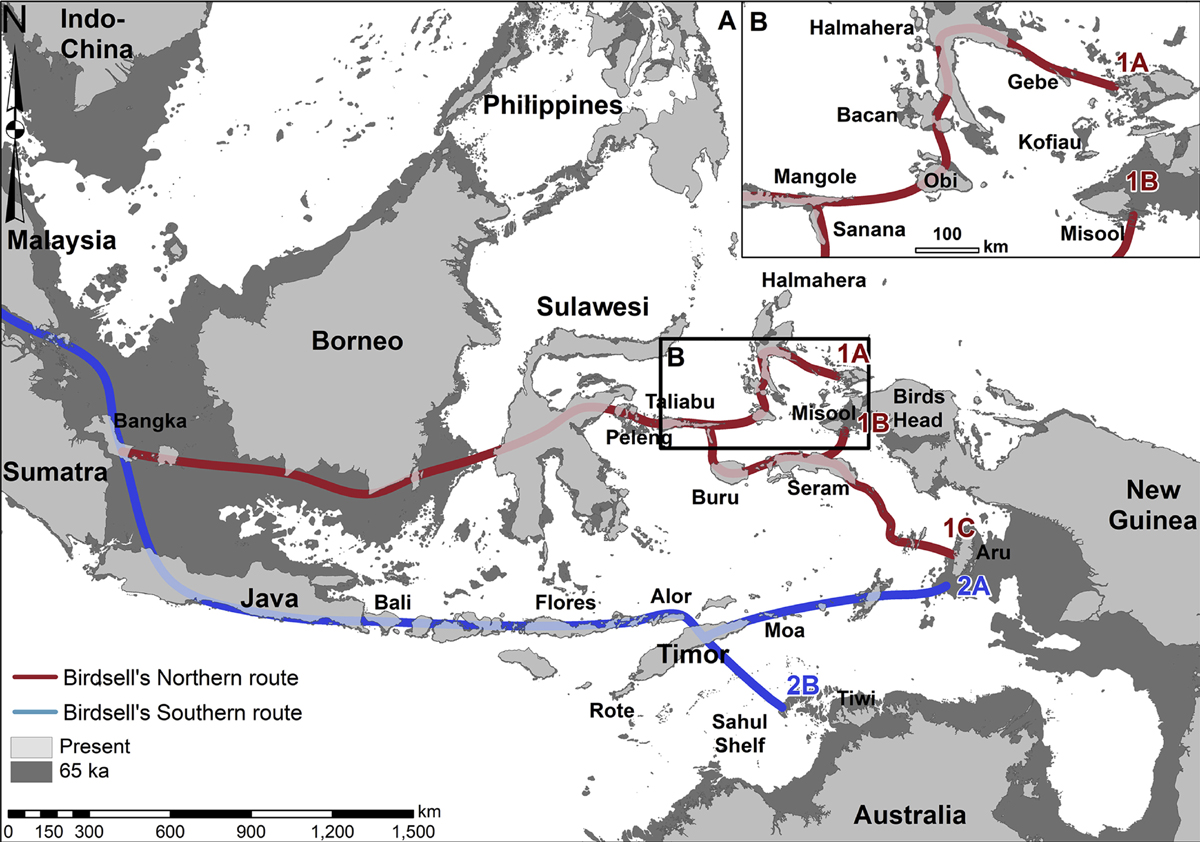


An article on phys.org from the Australian National University - Study finds most likely route of first humans into Australia - reports on new research which reveals the most likely route the ancestors of Aboriginal people took to enter Australia for the first time tens of thousands of years ago.
Co-lead researcher Shimona Kealy states that these people probably travelled through Indonesia's northern islands, into New Guinea and then Australia, which were part of a single continent between 50,000 and 70,000 years ago, when sea levels were 25-50 metres below the current level.
Ms Kealy, a Ph.D. scholar at the School of Culture, History and Language and an Associate Investigator at the ARC Centre of Excellence for Australian Biodiversity and Heritage at ANU, explains that a 'treasure map' of sorts has been created with the likely route across land and water that these 'incredible' people took to reach Australia. The researchers have circled all of the islands that they want to explore further to find archaeological evidence to test if this is in fact the path that they took. Archaeologists have yet to explore most of Indonesia's northern islands for human settlements predating the oldest sites found in Australia. These islands could hold the key to the mystery of how the first humans made it to Australia's shores.
The findings challenge a popular theory that these early adventurers travelled from Southeast Asia, through Indonesia and Timor and then across sea to reach Australia's shores and land that is part of the Northern Territory today.

The study modelled the least-cost path from Southeast Asia to Australia, by considering factors such as difficulty to travel up slopes, visibility at sea, access to fresh water along the many potential pathways and the sophistication of maritime technology at the time.
Ms Kealy said the oldest dates for human occupation on the Australian-New Guinea continent (known as Sahul) represented the earliest, indirect evidence for sea faring by humans anywhere in the world. The islands directly north and west of Sahul (known as Wallacea) were never connected to the mainland, requiring multiple successful water crossings east from mainland Southeast Asia (Sunda). Co-lead researcher Professor Sue O'Connor from ANU states that the proposed alternative route through Timor onto the northwest coast of Australia is now seen as less likely as a result of this study's least-cost pathway modelling: the suggested route through Timor is also considered less likely given comprehensive archaeological evidence indicates the earliest human settlements in Timor are much younger than those found in Madjedbebe in Arnhem Land in the Northern Territory.
The study is published in the Journal of Human Evolution:
- Shimona Kealy et al. Least-cost pathway models indicate northern human dispersal from Sunda to Sahul,(2018)
- DOI: 10.1016/j.jhevol.2018.10.003
- Provided by: Australian National University
Stephen Oppenheimer is a world-recognised expert in the synthesis of DNA studies with archaeological and other evidence to track ancient migrations:
Read more:
Stephen Oppenheimer
Read more:
Stephen Oppenheimer Research Papers
by Bradshaw Foundation
Tuesday 21 March 2023
by Bradshaw Foundation
Tuesday 07 February 2023
by Bradshaw Foundation
Thursday 19 May 2022
by Bradshaw Foundation
Tuesday 19 October 2021
by Bradshaw Foundation
Friday 25 June 2021
by Bradshaw Foundation
Monday 09 November 2020
by Bradshaw Foundation
Tuesday 03 November 2020
by Bradshaw Foundation
Wednesday 28 October 2020
by Bradshaw Foundation
Tuesday 23 June 2020
by Bradshaw Foundation
Thursday 04 June 2020
by Bradshaw Foundation
Thursday 14 May 2020
by Bradshaw Foundation
Tuesday 12 May 2020
by Bradshaw Foundation
Wednesday 19 February 2020
by Bradshaw Foundation
Tuesday 21 January 2020
by Bradshaw Foundation
Monday 20 January 2020
by Bradshaw Foundation
Thursday 28 November 2019
by Bradshaw Foundation
Tuesday 21 March 2023
by Bradshaw Foundation
Tuesday 07 February 2023
by Bradshaw Foundation
Thursday 19 May 2022
by Bradshaw Foundation
Tuesday 19 October 2021
by Bradshaw Foundation
Friday 25 June 2021
by Bradshaw Foundation
Monday 09 November 2020
by Bradshaw Foundation
Tuesday 03 November 2020
by Bradshaw Foundation
Wednesday 28 October 2020
by Bradshaw Foundation
Tuesday 23 June 2020
by Bradshaw Foundation
Thursday 04 June 2020
by Bradshaw Foundation
Thursday 14 May 2020
by Bradshaw Foundation
Tuesday 12 May 2020
by Bradshaw Foundation
Wednesday 19 February 2020
by Bradshaw Foundation
Tuesday 21 January 2020
by Bradshaw Foundation
Monday 20 January 2020
by Bradshaw Foundation
Thursday 28 November 2019
Friend of the Foundation











